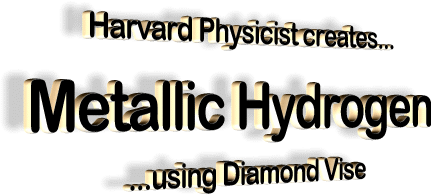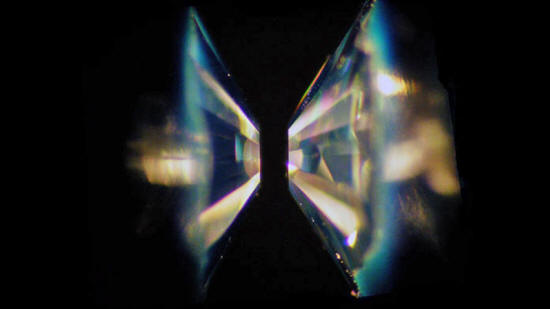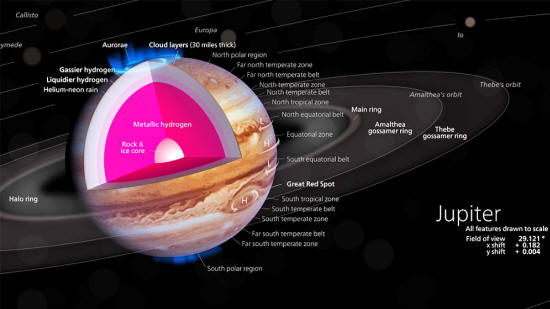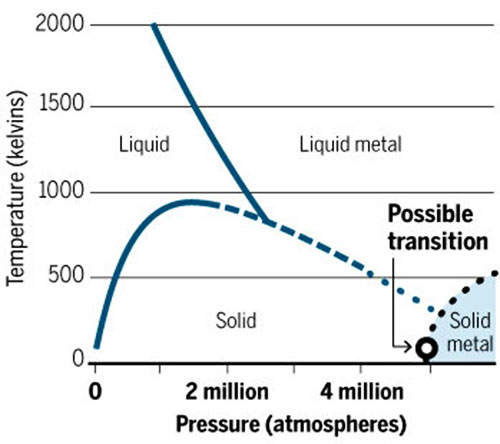|
by Robert F. Service
from
Sciencemag Website scientists squeezed hydrogen
to
pressures above those in Earth's core.
Word got around, and the next morning there was a line. Throughout the day, hundreds filed in to peer through a benchtop microscope at a reddish silver dot trapped between two diamond tips.
Silvera finally closed shop at 6 p.m. to go home.
That excitement swirled because by squeezing hydrogen to pressures well beyond those in the center of Earth, Silvera and his postdoc Ranga Dias had seen a hint that it had morphed into a solid metal, capable of conducting electricity.
The feat, reported online (Observation of the Wigner-Huntington Transition to Metallic Hydrogen) this week in Science, is more than an oddity.
Solid metallic hydrogen is thought to be a superconductor, able to conduct electricity without resistance. It may even be metastable, meaning that like diamond, also formed at high pressures, the metallic hydrogen would maintain its state - and even its superconductivity - once brought back to room temperatures and pressures.
Still, claims of solid metallic hydrogen have come and gone before, and some experts want more proof.
Others in the contentious field are downright hostile to the result.
The dispute arises because high-pressure hydrogen experiments are hard to pull off, and even harder to interpret.
First, scientists place a thin metal gasket between two flat-tipped diamonds. The gasket holds the hydrogen in place between the tips as the diamonds are cranked together.
The intense pressure can force hydrogen into defects on the surface of the diamonds, causing them to become brittle and crack.
So researchers have learned to apply transparent protective coatings to their diamonds. But the additional material makes it tricky to interpret laser measurements of what's going on in the center.
Furthermore, past pressures of about 400 gigapascals (GPa) - about 4 million times atmospheric pressure - the hydrogen turns black, preventing laser light from getting in.
This cut-away illustrates a model of the interior of Jupiter, with a rocky core overlaid by a deep layer of liquid metallic hydrogen. Credit: Kelvinsong/Wikimedia Commons
Scientists have already made liquid metal hydrogen - the substance thought to form the interior of giant planets like Jupiter - by ramping up pressure at higher temperatures.
Silvera wanted to work at low temperatures and transform hydrogen into something still more exotic:
At cryogenic temperatures, hydrogen is a liquid. As the pressure rises, the liquid quickly becomes a nonmetallic solid (see diagram, below).
In 1935, Princeton University physicists Eugene Wigner and Hillard Bell Huntington predicted that beyond 25 GPa, the nonconductive solid hydrogen would become metallic.
But experimentalists passed that threshold decades ago with no sign of a solid metal.
Silvera and Dias claim they've pushed their cell into an unexplored realm of low temperature and extreme pressure, succeeding in part because they avoided continuous high-intensity laser monitoring that they say can also cause an anvil's diamonds to fail.
Eventually, as they neared 500 GPa, the black sample became shiny and reddish.
A low-intensity infrared laser - one that wouldn't risk stressing the diamonds - revealed a strong spike in the sample's reflectance, as expected from a metal. Only then did the Harvard pair use a different laser, in a procedure called Raman spectroscopy, to verify the peak pressure in the diamond cell.
Silvera and Dias concede that their reddish silver speck could be a liquid rather than a solid, and they have not dared to release it from their diamond-tipped vise.
But they are confident it is a metal - a "very convincing" claim, says Neil Ashcroft, a Cornell University physicist who predicted the superconductive state of hydrogen nearly 50 years ago.
Mikhail Eremets and others say they need more proof that the team has created a solid metal or even a metal at all.
He also wonders whether the team actually reached the claimed 495 GPa, because that is usually determined through continuous Raman laser monitoring.
Except for the final 495-GPa Raman measurement, Silvera and Dias were forced to estimate pressures from the number of turns of the screws on their anvils.
Raymond Jeanloz, a high-pressure physicist at the University of California, Berkeley, also wants to be sure the trapped speck is pure hydrogen, because the gasket or the diamond coating could have broken down and reacted at high pressures.
But Silvera remains steadfast.
A comparison of reflectance measurements from the center of the hydrogen dot and the surrounding gasket at 495 GPa suggests the hydrogen in the sample is pure, he says.
As for the pressure measurement, Silvera insists he and Dias have studied it closely and verified their calibration.
Silvera says they have just one experiment to report because they wanted to announce their result before running further tests that could break their vise. Soon, he says, they plan to run additional Raman laser tests that should reveal whether the sample has the regular atomic lattice expected of a solid metal.
Eventually they will unscrew the vice and see whether the metal is metastable. Then, they will begin the experiment again.
Claiming total victory in the "hydrogen wars," as Jeanloz calls them, will require another round or two of evidence.
Video
|




